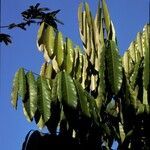An evergreen tree. It grows up to 25 m tall. The branches are crooked, spread out wide and curve over. It has a dense crown of leaves. The trunk is often fluted and the branches grow low down on the trunk. The bark is thin and smooth and dark grey. It has a gummy resin when cut. The leaves are very large and at the ends of the thick small branches. The young leaves are red then orange and change to green as they mature. They are divided into 6-9 pairs of leaflets. Each leaflet is oblong and about 25 cm long by 9 cm wide. The leaves have a rounded tip with a blunt point. The flowers are in a much branched head shaped like a pyramid. It is 70 cm long. Each flower has 5 yellow, pink and white petals about 1 cm long. The fruit is a large woody capsule 12-15 cm across. The fruit cracks open in 5 parts. There are 12-20 angular seeds inside. The seeds are 3 cm long and shiny dark brown. They have a rough pitted surface.
Habit varies from a sprawling tree with arching branches up to about 50 ft high, in swamp forest, to a tall tree with clear bole in lowland rain forest.
Large leaves clustered at the ends of the branches
Flowers white and pink, fragrant.
Forest trees


